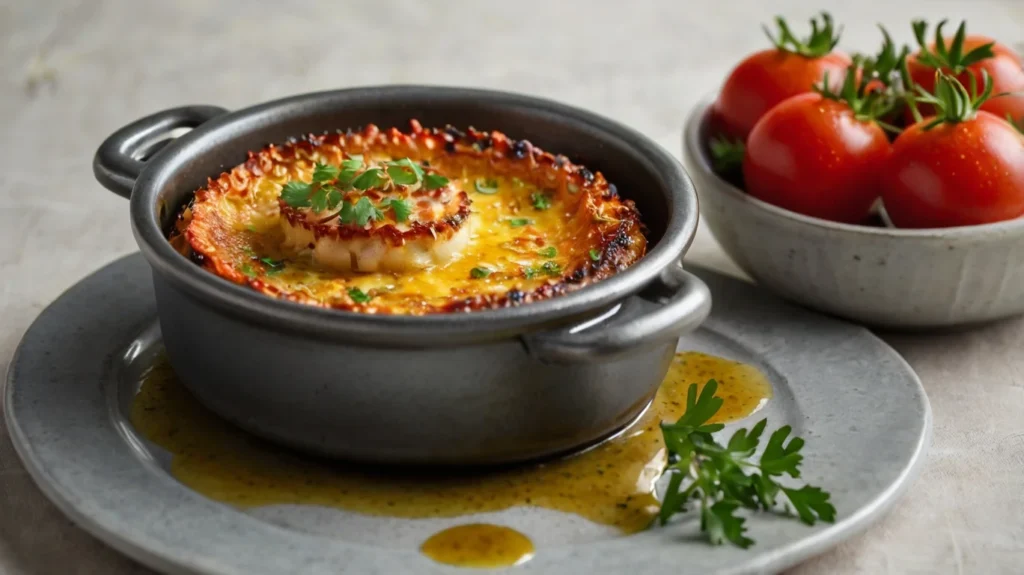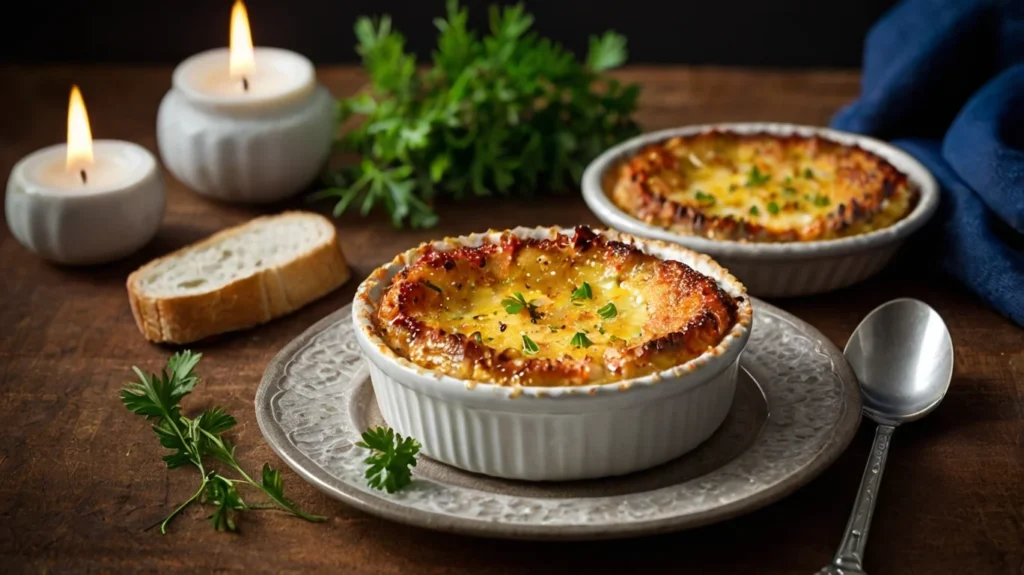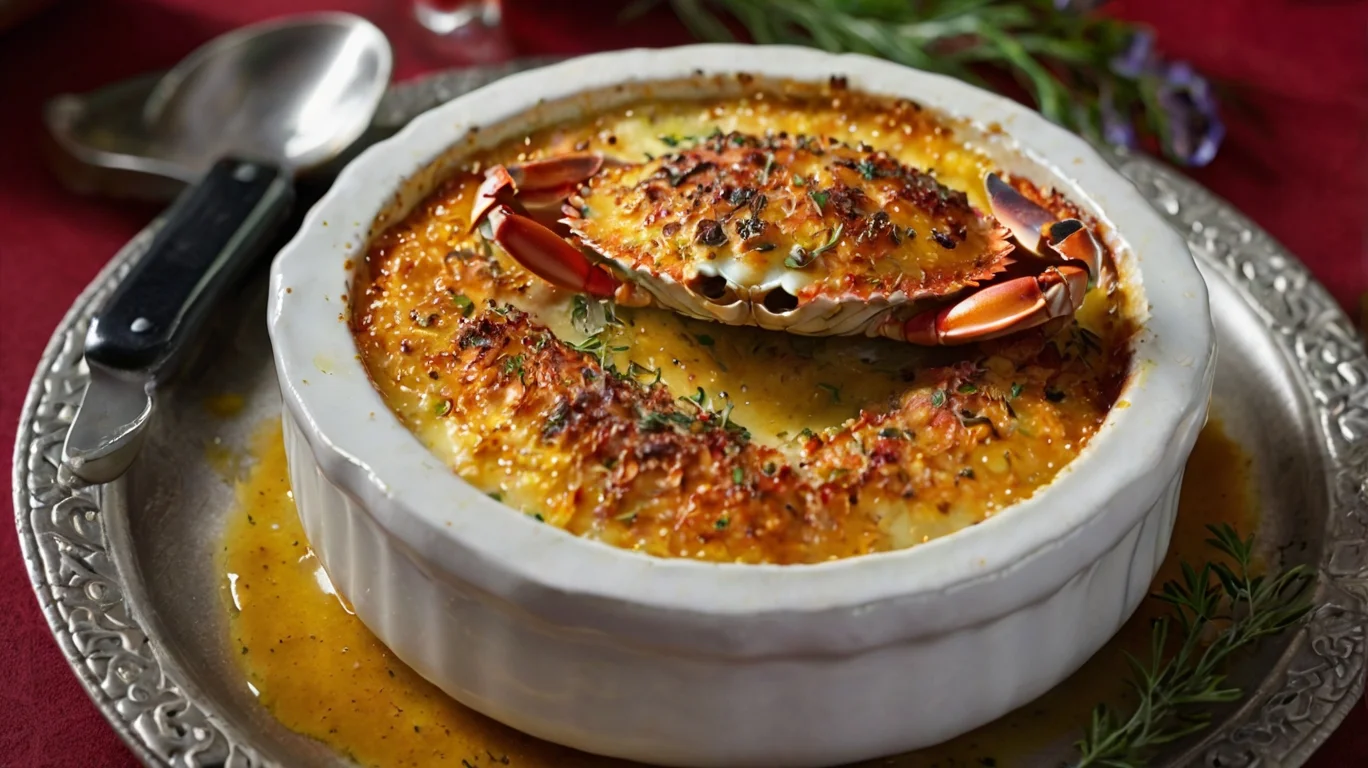Table of Contents
Introduction
Crab brûlée is a luxurious fusion of flavors that takes the classic dessert concept and gives it a savory seafood twist. Traditionally known as a sweet custard topped with a caramelized sugar crust, brûlée is reinvented with a rich, creamy crab filling that delights seafood enthusiasts and culinary adventurers alike. This dish marries the indulgent texture of crème brûlée with the subtle sweetness of fresh crab, creating a harmonious blend of flavors that captivates the palate.
The fusion of savory and sweet has long been a trend in culinary arts, showcasing the balance of contrasting flavors. Crab brûlée exemplifies this artistry by transforming a dessert into an elegant appetizer or side dish. The buttery notes of cream and cheese pair perfectly with the delicate taste of crab, while the caramelized sugar crust adds a hint of sweetness and crunch.
This recipe has been gaining popularity for its versatility and sophistication. It’s perfect for upscale dinner parties, festive occasions, or simply treating yourself to something extraordinary. Whether served as individual portions or a centerpiece dish, crab brûlée is a testament to how classic recipes can evolve into innovative masterpieces. Give this dish a try, and impress your guests with its unique charm!

What is Crab Brulee?
Crab brûlée is a unique culinary creation that combines the elegance of a classic crème brûlée with the rich, savory flavors of fresh crab. Unlike the traditional dessert, which relies on sugar and vanilla, this version uses savory ingredients like crab meat, cream, cheese, and aromatic herbs. The result is a creamy custard base infused with the delicate sweetness of crab, topped with a thin, caramelized sugar crust for a hint of crunch.
At its core, crab brûlée showcases the versatility of crab meat. Fresh crab is prized for its tender texture and naturally sweet flavor, making it the perfect foundation for this luxurious dish. The custard is enriched with heavy cream and egg yolks, ensuring a silky texture reminiscent of the classic dessert.
Inspired by French culinary traditions, crab brûlée reimagines a sweet classic into an indulgent appetizer or side dish. It represents a growing trend of blending savory and sweet elements in modern cuisine, offering a sophisticated way to enjoy the subtle flavors of seafood. Ideal for entertaining or a gourmet twist on seafood dining, crab brûlée is a standout example of innovation in the kitchen.

Ingredients for the Perfect Crab Brulee
Essential Ingredients
To create a delicious and creamy crab brûlée, you’ll need a few key ingredients that form the foundation of this savory dish:
- Fresh crab meat: Opt for high-quality lump or claw meat for the best flavor and texture.
- Heavy cream: Adds richness and a velvety consistency to the custard.
- Egg yolks: Essential for achieving the silky custard texture.
- Parmesan cheese: Provides a subtle, nutty flavor that complements the crab.
- Garlic and shallots: Aromatics that enhance the savory depth of the dish.
- Herbs: Fresh chives and parsley add brightness and balance.
- Lemon zest: Lends a hint of acidity to elevate the flavors.
- Salt and pepper: For seasoning and flavor enhancement.
Optional Add-Ins
Customize your crab brûlée with these optional ingredients for added flavor and flair:
- Truffle oil: A drizzle of this luxurious oil adds earthy, aromatic depth.
- Gruyere cheese: Incorporate this creamy, slightly sweet cheese for a richer taste.
- Paprika for garnish: A sprinkle of smoked or sweet paprika provides a pop of color and subtle spice.
Experiment with these ingredients to tailor the dish to your personal preferences and impress your guests with every bite!
Step-by-Step Instructions
Preparing the Crab Mixture
The first step in creating the perfect crab brûlée is preparing the flavorful crab mixture. Begin by picking through the fresh crab meat to remove any bits of shell or cartilage. Use a gentle touch to avoid breaking the meat too finely; chunks of crab enhance the texture of the dish. If using pre-packaged crab, drain any excess liquid to prevent the mixture from becoming watery.
In a skillet, heat a small amount of butter or oil over medium heat. Sauté minced garlic and finely chopped shallots until fragrant and translucent, about 2–3 minutes. Add a pinch of salt and pepper to season. Once cooked, let the aromatics cool slightly before mixing them into the crab meat. This step infuses the crab mixture with a savory, aromatic base that forms the heart of the brûlée.
Making the Custard Base
In a mixing bowl, whisk together egg yolks and heavy cream until fully combined and smooth. The yolks provide richness, while the cream ensures a luscious texture. Gradually fold in the prepared crab mixture, Parmesan cheese, fresh herbs, and lemon zest, stirring gently to maintain the crab’s integrity. Season with additional salt and pepper to taste.
Baking and Caramelizing
Preheat your oven to 325°F (160°C). Divide the custard mixture evenly into ramekins. Place the ramekins in a baking dish and fill it with hot water until it reaches halfway up the sides of the ramekins, creating a water bath to ensure even baking. Bake for 25–30 minutes or until the custard is just set.
Before serving, sprinkle a thin, even layer of sugar on top of each brûlée. Use a kitchen torch to caramelize the sugar until golden and crisp. Serve immediately for the perfect balance of creamy and crunchy!
Tips for the Perfect Crab Brulee
Choosing Fresh Versus Canned Crab
For the best flavor and texture, always opt for fresh crab meat when possible. Fresh crab has a natural sweetness and a firm, flaky texture that elevates the dish. If fresh crab isn’t available, high-quality canned or pasteurized crab can work as a substitute. Be sure to drain and pat it dry to avoid excess moisture, which can affect the custard’s consistency.
Using the Right Type of Sugar for Caramelization
The sugar topping is key to achieving the classic brûlée crust. Use granulated sugar for a smooth, even caramelization. Avoid brown sugar, as its higher moisture content can make the crust sticky instead of crisp. Sprinkle an even, thin layer of sugar over the surface to ensure it caramelizes evenly under the torch.
Adjusting Cream-to-Egg Ratio for Texture
The balance between cream and egg yolks is crucial for a silky, creamy texture. A higher ratio of cream will yield a softer custard, while more egg yolks result in a firmer consistency. For a perfect balance, use 1 cup of heavy cream for every 3–4 large egg yolks. Adjust the ratio to suit your preferred texture while maintaining the richness that makes crab brûlée so indulgent.
By following these tips, you’ll create a crab brûlée that’s perfectly creamy, flavorful, and topped with a golden, crisp crust every time!
Pairing and Serving Suggestions
Ideal Pairings
Crab brûlée pairs beautifully with a crisp, lightly oaked Chardonnay. The wine’s buttery notes complement the richness of the dish, while its acidity balances the creamy custard. Alternatively, a dry Riesling or Sauvignon Blanc offers a refreshing contrast to the savory flavors.
For accompaniments, serve crab brûlée with toasted baguette slices or crackers for added texture and to scoop up the creamy custard. A side of lightly dressed mixed greens or arugula provides a refreshing, tangy contrast to the dish’s richness. You can also pair it with a simple cucumber salad or steamed asparagus to complete the meal.
Creative Presentations
Crab brûlée can be served in individual ramekins for an elegant, restaurant-style experience. Alternatively, prepare it in a larger baking dish for a family-style presentation, allowing guests to serve themselves. For an eye-catching touch, garnish with a sprig of fresh herbs or a sprinkle of paprika before serving.
Variations of Crab Brulee
Gluten-Free Option
To make a gluten-free crab brûlée, ensure no gluten-containing thickeners or ingredients are used. Replace any flour in the recipe with almond flour or cornstarch to achieve the desired consistency without compromising texture or flavor. Double-check all store-bought ingredients, such as cheese, for gluten-free certification.
Spicy Crab Brulee
For a bold and zesty variation, incorporate a pinch of cayenne pepper or red chili flakes into the custard mixture. This adds a touch of heat that complements the natural sweetness of the crab. You can also garnish the brûlée with a dash of smoked paprika for added spice and color.
Vegan-Friendly Twist
Transform this dish into a plant-based option by substituting crab meat with shredded jackfruit, which mimics the texture of crab. Replace heavy cream with coconut cream or cashew cream for a creamy base. Use a vegan egg substitute, like silken tofu or aquafaba, to create the custard consistency.
Asian-Inspired Crab Brulee
Add an Asian flair to your crab brûlée by mixing a teaspoon of white miso paste and a drizzle of sesame oil into the custard. Garnish with finely chopped green onions and a sprinkle of toasted sesame seeds for an umami-packed variation that’s both unique and flavorful.
Common Mistakes and How to Avoid Them
Overcooking the Custard
One of the most common pitfalls is overcooking the custard, which results in a grainy texture instead of the desired silky smooth consistency. To avoid this, bake the crab brûlée in a water bath at a low temperature (325°F/160°C) and remove it from the oven as soon as the edges are set but the center still jiggles slightly. The custard will continue to set as it cools.
Burning the Sugar Crust
Achieving the perfect caramelized crust can be tricky. Using a kitchen torch, keep the flame moving to avoid scorching any single spot. If using a broiler, place the ramekins on the middle rack and keep a close eye on them, as the sugar can burn quickly. An even layer of granulated sugar will caramelize uniformly and prevent clumping.
Balancing Flavors
Too much salt, cream, or sweetness can overwhelm the delicate taste of the crab. To maintain balance, taste the mixture before baking and adjust the seasoning gradually. Use fresh lemon zest or a dash of herbs to brighten the flavors without overpowering the natural sweetness of the crab. With proper attention, each bite will be perfectly harmonious.
FAQs
What is the secret of crème brûlée?
The secret to a perfect crème brûlée lies in the texture of the custard and the caramelized sugar crust. A slow, even bake in a water bath ensures a silky-smooth custard, while the thin layer of sugar caramelized with a torch provides the iconic crunchy topping.
What’s the difference between crème brûlée and custard?
Crème brûlée is a specific type of custard topped with a caramelized sugar crust, whereas custard refers to a broader category of dishes made with eggs, milk, and sugar. Crème brûlée is often richer, using heavy cream, and includes the step of torching the sugar.
What can I use instead of ramekins for crème brûlée?
If you don’t have ramekins, shallow oven-safe dishes like small Pyrex bowls, ceramic baking dishes, or wide coffee cups can work. The key is to use a shallow dish to create the perfect ratio of custard to sugar crust.
What is the burnt sugar on crème brûlée called?
The burnt sugar topping is known as the caramelized sugar crust, achieved by sprinkling sugar over the custard and heating it until it melts and hardens into a crisp layer.
How to mess up crème brûlée?
Common mistakes include overcooking the custard, which results in a grainy texture, or undercooking it, leaving it soupy. Another misstep is using too much sugar, which can lead to an overly thick or burnt crust.
What’s the difference between crème brûlée and caramel brûlée?
The difference lies in the flavor profile. Crème brûlée has a neutral vanilla base, while caramel brûlée incorporates caramel into the custard for a deeper, richer flavor. Both share the signature caramelized sugar topping.
Conclusion
Crab brûlée is a stunning fusion of elegance and indulgence, offering a savory twist on the beloved classic dessert. Its creamy custard base, infused with the delicate sweetness of fresh crab and balanced by aromatic herbs and a hint of citrus, creates a symphony of flavors. Topped with a golden caramelized sugar crust, this dish showcases a perfect interplay of textures—silky smooth custard contrasted by a crisp, crackling topping.
What makes crab brûlée truly unique is its versatility. Whether served as an appetizer, a side dish, or the centerpiece of a gourmet spread, it elevates any dining experience with its sophisticated presentation and luxurious taste. Its ability to adapt to personal preferences, with variations like spicy, gluten-free, or even Asian-inspired renditions, ensures there’s a version to suit every palate.
Pairing this dish with a Caesar Salad or a comforting Caldo de Pollo can enhance the dining experience. Or, explore additional seafood options, such as a Steelhead Trout Recipe or Shrimp Pasta Recipes, for a complete gourmet meal.
By following the steps and tips provided, you can create a restaurant-worthy dish that’s sure to impress family and guests alike. So, why not try your hand at crafting this extraordinary recipe? Crab brûlée is more than just a recipe—it’s an opportunity to explore new culinary horizons and add a touch of sophistication to your table.

